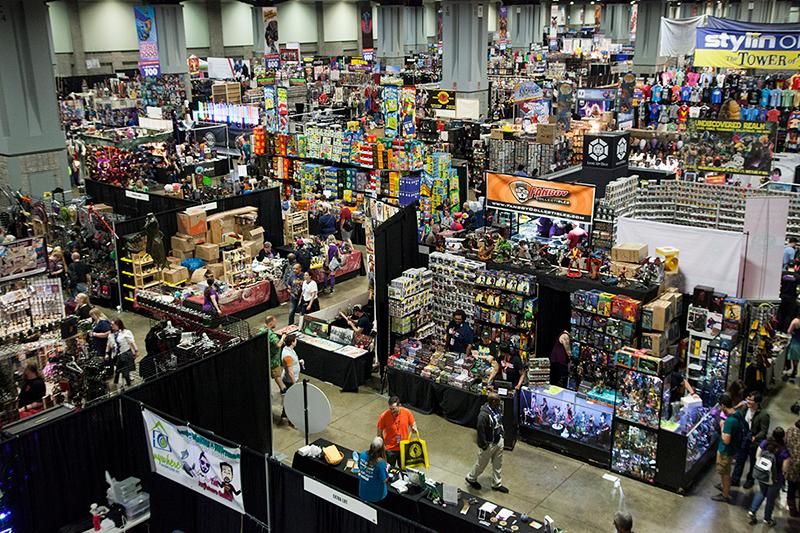This Year’s Future Con Showcased Cutting-Edge Science and Real-Life Superheroes
A part of Washington, D.C.’s Awesome Con, the dynamic presentation series blends entertainment and education
/https://tf-cmsv2-smithsonianmag-media.s3.amazonaws.com/filer/93/c6/93c68599-74e0-4668-8c54-9193b7aab1f6/jim_bridenstine.jpg)
For seven years running, Washington, D.C’s springtime Awesome Con has united passionate nerds of every stripe for a weekend steeped in the culture of science fiction, comic books, creature features and cosplay. But don’t be fooled by all the fun they’re having: fans of Awesome Con are as intellectually curious as convention-goers come, and some of the most exciting events at the Con each year are deep discussions of real-world science and tech.
These heady but rewarding sessions fall under the banner of Future Con, a joint effort by Smithsonian magazine and Awesome Con to spread surprising knowledge and expose people of all ages to the thrill and mystery of science. At this year’s Con, attended by tens of thousands from April 26-28 (also aptly Marvel’s biggest movie weekend to date), Future Con sessions covered an impressive smorgasbord of topics spanning three broad categories: space, humans and pop culture.
At all of these presentations and panel talks, the science pros onstage were sure to allot ample time for audience Q&A and otherwise invite folks to join the dialogue. Picture the Dread Pirate Roberts, hero of The Princess Bride, asking a question about astronomy and you’ll get a good sense of the participatory vibe.
Space
Space exploration was one of the most popular topics at this year’s Future Con, and with good reason: space has long enthralled both scientists and science-fiction enthusiasts, with the two groups influencing one another in a delicious reciprocal relationship across the centuries.
On Saturday, NASA administrator Jim Bridenstine and other space leaders described how their passion for space—sparked in part by movies like Spaceballs, Star Trek and SpaceCamp—blossomed into careers, and how sci-fi has contributed to the development of new space technologies.
A panel from NASA’s Goddard Space Flight Center on Friday gave an exciting overview of the agency’s ongoing search for life within our own solar system and beyond. Planetary scientist Dave Williams pointed to the subsurface ocean of Jupiter’s moon Europa and the water plumes of Saturn’s Enceladus as two high-value targets, noting that even the dwarf planet Ceres has tantalizing water ice just beneath its rocky surface. Astronomer Lou Mayo called Saturn’s satellite Titan Earth’s true sister, pointing out the major similarities between Titan’s “methane cycle” and our own water cycle.
Exoplanet specialist Giada Arney, for her part, suggested that the best bet for identifying extraterrestrial life might be the study of the myriad exoplanets uncovered by NASA’s Kepler spacecraft and high-powered telescopes. Arney says that we are getting better and better at recognizing traces of life from afar (provided that life is on the surface and not below), and she would not be surprised if we detected life on an exoplanet in the near future.

Other notable space talks this weekend centered on our growing understanding of black holes, drawing large audiences in the wake of the Event Horizon Telescope’s unprecedented composite imaging of a supermassive one at the heart of the M87 galaxy some 55 million light-years away.
A Sunday panel dealt specifically with supermassive black holes, which dwarf the mass of our sun by factors of millions or billions and, like the M87 example, tend to inhabit the centers of galaxies. Many lie dormant, the panel explained, but not all, and we can detect the active ones (“active galactic nuclei,” in NASA-speak) thanks to the luminous halos of their accretion disks, which result from the intense friction of matter getting sucked inexorably to the center.
A small fraction of supermassive black holes also emit extremely energetic “plasma jets,” searing gouts of plasma that shoot outward from just beyond the hole’s event horizon, travel nearly at light speed, and alter the makeup of whatever stretches of galaxy they cross. Scientists are still puzzling out the mechanics behind this phenomenon.
The most ambitious space talk of the convention was likely astrophysicist Erin Macdonald’s in-depth overview of gravity waves—ripples in spacetime resulting from the action of gravitational fields. In his theory of general relativity, Einstein predicted the existence of gravity waves, and now, thanks to the work of the Nobel-winning Laser Interferometer Gravitational-Wave Observatory (LIGO), we have concrete data in support of their existence.
The first gravity waves LIGO’s ultra-sensitive equipment ever detected (back in 2015) were the result of two black holes colliding some 1.3 billion light-years away. In other words, Macdonald explained, we here on Earth picked up the spacetime fingerprint of an event that took place 1.3 billion years ago.
LIGO has since observed many more such black hole mergers, and, in collaboration with the European Virgo interferometer, has linked short bursts of far-off gamma rays to the collisions of neutron stars. Macdonald can’t wait for the discoveries just around the corner—and now, neither can the members of her audience.
Humans
As a more down-to-earth counterpoint to all the discourse on moons and gravity wells, Future Con also offered several stimulating talks on human-oriented innovation.
On Saturday, representatives from the National Geospatial-Intelligence Agency (NGA) described their work (the unclassified aspects, at least) preparing meticulously detailed scale models—both physical three-dimensional ones and interactive digital ones—of locations and structures of national importance.
Drawing on satellite, helicopter and other overflight visual data, members of the NGA fabricate models for clients including the Department of Defense and other arms of the national security apparatus. At the talk, they showed off a digital rendering of an Ebola treatment center, vehicular mock-ups of tanks and biplanes, and physics-intensive simulations of flooding in Chile and Iraq.
Both speakers came to the NGA via the entertainment industry, and they noted that the use of popular video game engines such as Unreal and Unity enables them to render their models more fully and compellingly, giving users the option of digitally immersing themselves and exploring the virtual locales from within at their own pace.

One standout event in the human-oriented Future Con series was Saturday evening’s discussion on CRISPR genetics and its applications—helpful as well as harmful. Molecular biology writer Tina Saey opened the discussion by defining CRISPR for the audience. Characterizing it as “basically an immune system for bacteria,” she explained how bacterial cells can take genetic “mugshots” of the viruses that attack them and then use those mugshots to break them up on future encounters. She then explained how humans have harnessed this technique to cut DNA wherever they like, opening the door to a Wild West of genetic manipulation.
There’s no denying CRISPR techniques have brought about some astonishing medical results. Virologist Anne Simon cited the example of “bubble boy disease,” whose victims lack functional immune systems and are thus likely to die early on in life from exposure to everyday viruses. With CRISPR, this condition needn’t be a death sentence: Simon said that scientists can now extract patients’ stem cells, modify them genetically with CRISPR techniques, and reinject them to build a brand-new immune system from the ground up.
In a nod to the pop cultural side of the Con, Simon, who consulted on a CRISPR-driven episode of The X-Files, also offered a cautionary tale on CRISPR. In the doomsday scenario she concocted for the show, baddies manage to inject people with malicious CRISPR that removes rather than creates their immune apparatus, causing bubble boy disease instead of curing it. While the show took a couple shortcuts, Simon explained that what was depicted wasn’t far from the realm of possibility, and that it illustrates the need for the scientific community to tread carefully with this potent new technology.
Pop Culture
Last but not least were the Future Con talks that used the fiction beloved by Con-goers as a springboard to get them thinking about real-world science and real-world social issues to boot.
One such event on Friday brought a panel well versed in both science and pop culture together to field audience questions on the plausibility or (more often) implausibility of various conceits from comic books and sci-fi.

Biologist Eric Spana maintained that the easiest X-Men mutation to swallow was Wolverine’s scarless healing—a trait that has actually been observed in the tissue of fetal humans (though never in adults). He has bad news for Nightcrawler and Beast, though: “It is really hard for a vertebrate to be blue.”
Spana’s Duke University colleague Mohamed Noor tackled the topic of plant life on alien worlds, contending that finding flora on faraway planets identical in structure to Earth’s plants (as they often appear onscreen) would be “astronomically improbable.” From the cellular level on up, he says, they would likely be much different—though photosynthesis in isolation is a property he wouldn’t be surprised to encounter off-world.
In addition to the above, the panel addressed such topics as Thor’s hammer (which perhaps emits gravitons at a variable frequency?), Spider-Man’s bite (venom doesn’t contain genetic material—sorry Spidey), and the bodily dangers of prolonged space travel (astrophysicist Joe Pesce is “more worried about the radiation than the g-forces”).
One other noteworthy pop culture panel—an all-female discussion helmed by National Air and Space Museum curator Margaret Weitekamp—brought a scientific lens to Captain Marvel. As it turns out, the intergalactic pager Carol Danvers jury-rigs in the film isn’t as far-fetched as it initially seems; the panel pointed out that satellite pagers have existed for a while, and that if we buy into the fiction of a “jump point” near Earth, all she would have had to do was juice up the device so its signal could be bounced through that jump point via satellite.
A little less convincing were the onscreen technologies of hologram communicators and full visual aircraft cloaking—both of which are not beyond the realm of achievability in real life, but at the moment are nowhere near cost-effective. You don’t get much added utility from transmitting a hologram of someone rather than just talking to them or making a plane invisible rather than just reducing its thermal and electronic signatures.
One aspect of the movie that real-life pilot and helicopter vendor Jeanette Eaton found extremely realistic was the camaraderie between Danvers and her flight partner Maria Rambeau. “Female-female crews are tight,” she explains—women pilots tend to work together extremely efficiently. Lockheed Martin engineer Lynnette Drake added what was likely the panel’s most important takeaway: that Captain Marvel “was most powerful when she believed in herself.”
. . .
Awesome Con is known for inviting devoted nerds to go a little wild each year and fly their fandom flags proudly, and this April’s extravaganza was no exception. But the Con’s message of science positivity will stick with you long after the Dungeons & Dragons sessions have wrapped and the video arcade games have shut down. Dressing up as Chewbacca every day may not be feasible, but a love of science is something all of us can put into practice year-round.
/https://tf-cmsv2-smithsonianmag-media.s3.amazonaws.com/accounts/headshot/DSC_02399_copy.jpg)
/https://tf-cmsv2-smithsonianmag-media.s3.amazonaws.com/accounts/headshot/DSC_02399_copy.jpg)